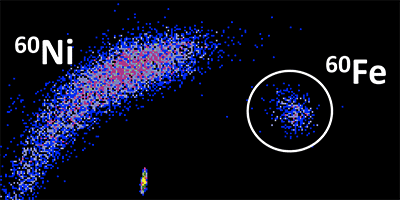February 2, 2015 weblog
Physicists reach new milestone measuring half-life of iron-60

(Phys.org)—A team of physicists affiliated with institutions in Australia, Switzerland and Austria has made the most accurate measurement to date of the half life of iron-60. In their paper published in the journal Physical Review Letters, the team describes their approach and note that their efforts will now allow the isotope to be used to date astronomical events.
On most places on Earth, iron is found as iron-56, a stable element. Elsewhere in the universe, however, it is found with four additional neutrons which make it a radioactive isotope—iron-60. The isotope is considered by cosmologists to be a radionuclide which has gone extinct—they believe it was created by multiple processes in the early stages of the development of our solar system. Bits of the isotope have been found to exist naturally on Earth only on ocean beds, and are believed to have got there as part of meteorites.
Over the years, scientists have tried various techniques to measure the half-life of the isotope, but have not been able to do so with enough precision to make the results useful. In 1984, for example, a team made the attempt and found it to be roughly 1.5 million years, while another effort in 2009 led to an estimate of 2.6 million years—such a discrepancy has prevented the use of iron-60 being used as a chronometer. In this new effort, the researchers started by using the same technique as the team in 1984, accelerator mass spectrometry.
That allowed them to measure the concentration of iron-60 in a sample. Then instead of using the half-life of the isotope itself, they compared the number of isotopes they had found to concentrations of iron-55, that allowed them to measure the half-life of iron-60 to be 2.6 million years (the same as was found by the team in 2009) to a degree of just two percent uncertainty. That is low enough for the isotope to be used as a chronometer—researchers can use it to calculate the time-scales of a cosmic processes. It is believed that using iron-60 as a chronometer will allow for dating events such as supernovae and some other stars.
More information: Settling the Half-Life of 60Fe: Fundamental for a Versatile Astrophysical Chronometer, Phys. Rev. Lett. 114, 041101 – Published 28 January 2015. journals.aps.org/prl/abstract/ … ysRevLett.114.041101
ABSTRACT
In order to resolve a recent discrepancy in the half-life of Fe60, we performed an independent measurement with a new method that determines the Fe60 content of a material relative to Fe55 (t1/2=2.744 yr) with accelerator mass spectrometry. Our result of (2.50±0.12)×106 yr clearly favors the recently reported value (2.62±0.04)×106 yr, and rules out the older result of (1.49±0.27)×106 yr. The present weighted mean half-life value of (2.60±0.05)×106 yr substantially improves the reliability as an important chronometer for astrophysical applications in the million-year time range. This includes its use as a sensitive probe for studying recent chemical evolution of our Galaxy, the formation of the early Solar System, nucleosynthesis processes in massive stars, and as an indicator of a recent nearby supernova.
Journal information: Physical Review Letters
© 2015 Phys.org




















